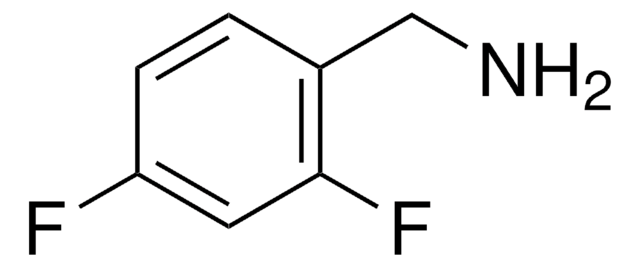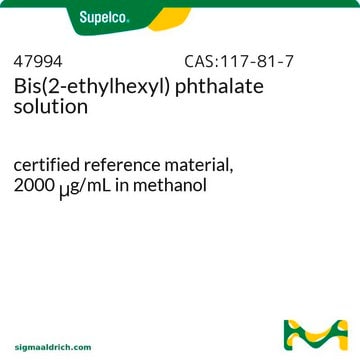If this product has an expiration or retest date, it will be shown on the Certificate of Analysis (COA, CofA). If there is no retest or expiration date listed on the product's COA, we do not have suitable stability data to determine a shelf life. For these products, the only date on the COA will be the release date; a retest, expiration, or use-by-date will not be displayed.
For all products, we recommend handling per defined conditions as printed in our product literature and website product descriptions. We recommend that products should be routinely inspected by customers to ensure they perform as expected.
For products without retest or expiration dates, our standard warranty of 1 year from the date of shipment is applicable.
For more information, please refer to the Product Dating Information document: https://www.sigmaaldrich.com/deepweb/assets/sigmaaldrich/marketing/global/documents/449/386/product-dating-information-mk.pdf
D201154
Dioctyl phthalate
≥99.5%
Synonym(s):
Bis(2-ethylhexyl) phthalate, DEHP, DOP, Phthalic acid bis(2-ethylhexyl ester)
About This Item
Recommended Products
vapor density
>16 (vs air)
Quality Level
vapor pressure
1.2 mmHg ( 93 °C)
Assay
≥99.5%
form
oil
autoignition temp.
734 °F
impurities
≤0.05% water (Karl Fischer)
color
APHA: ≤10
refractive index
n25/D 1.483-1.487
n20/D 1.486 (lit.)
bp
384 °C (lit.)
mp
−50 °C (lit.)
density
0.985-0.987 g/mL at 20 °C
0.985 g/mL at 25 °C (lit.)
suitability
suitable for acidity (
<=0.003%as phthalic acid
)SMILES string
CCCCC(CC)COC(=O)c1ccccc1C(=O)OCC(CC)CCCC
InChI
1S/C24H38O4/c1-5-9-13-19(7-3)17-27-23(25)21-15-11-12-16-22(21)24(26)28-18-20(8-4)14-10-6-2/h11-12,15-16,19-20H,5-10,13-14,17-18H2,1-4H3
InChI key
BJQHLKABXJIVAM-UHFFFAOYSA-N
Looking for similar products? Visit Product Comparison Guide
Related Categories
Signal Word
Danger
Hazard Statements
Precautionary Statements
Hazard Classifications
Repr. 1B
Storage Class Code
6.1C - Combustible acute toxic Cat.3 / toxic compounds or compounds which causing chronic effects
WGK
WGK 1
Flash Point(F)
404.6 °F - closed cup
Flash Point(C)
207 °C - closed cup
Personal Protective Equipment
Choose from one of the most recent versions:
Already Own This Product?
Find documentation for the products that you have recently purchased in the Document Library.
Customers Also Viewed
-
How can I determine the shelf life / expiration / retest date of this product?
1 answer-
Helpful?
-
-
How is shipping temperature determined? And how is it related to the product storage temperature?
1 answer-
Products may be shipped at a different temperature than the recommended long-term storage temperature. If the product quality is sensitive to short-term exposure to conditions other than the recommended long-term storage, it will be shipped on wet or dry-ice. If the product quality is NOT affected by short-term exposure to conditions other than the recommended long-term storage, it will be shipped at ambient temperature. As shipping routes are configured for minimum transit times, shipping at ambient temperature helps control shipping costs for our customers. For more information, please refer to the Storage and Transport Conditions document: https://www.sigmaaldrich.com/deepweb/assets/sigmaaldrich/marketing/global/documents/316/622/storage-transport-conditions-mk.pdf
Helpful?
-
-
How many mg of phthalate does 1 millimeter contain?
1 answer-
This product is a neat or pure oil. The density at 20 °C is 0.985 g/mL and the molecular weight is 390.56 g/mol for the pure material. The minimum purity specification is 99.5% with up to 0.05% water possible. The molecular weight of phthalic acid is 164.11 g/mol which is 42% of the total molecular weight of this material. As an example, the 5 mL package size will contain approximately 4.925 grams of dioctyl phthalate, based on the above density. To determine the amount of phthalate in 4.925 grams of dioctyl phthalate, multiply the mass by the percentage of phthalate as follows:
4.925 x 0.42 = 2.0685 grams of phthalate per 5 mL pack size
Note that this is an approximation and will differ from lot to lot, based on the purity, water content, and specific gravity reported in the Certificate of Analysis. Please see the link below to review a sample or lot specific Certificate:
https://www.sigmaaldrich.com/product/aldrich/d201154#product-documentationHelpful?
-
-
a dioktilftalát azonos a Mesamoll márkanevű anyaggal?
1 answer-
Both Mesamill and Dioctyl Phthalate are widely used plasticizers, however they are unique and separate compounds with different physical properties. The CAS number for Mesamoll® is 91082-17-6 and the CAS for Dioctyl Phthalate is 117-81-7.
Helpful?
-
Active Filters
Our team of scientists has experience in all areas of research including Life Science, Material Science, Chemical Synthesis, Chromatography, Analytical and many others.
Contact Technical Service






